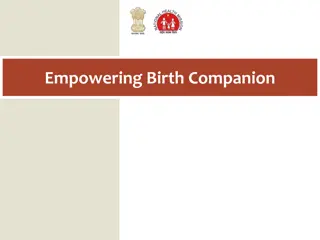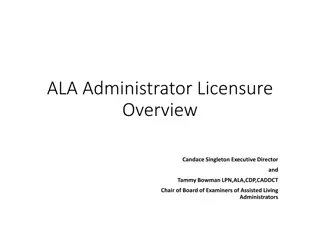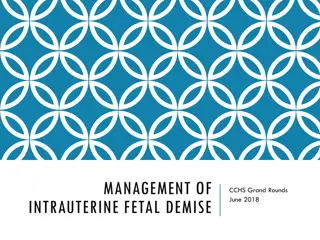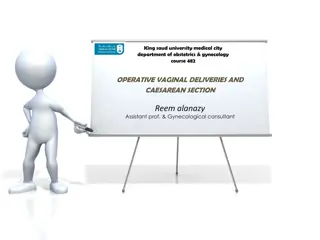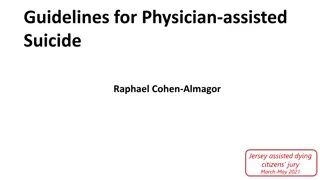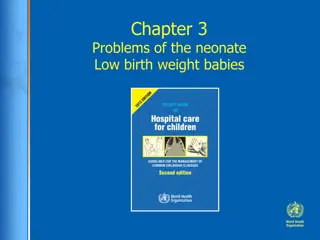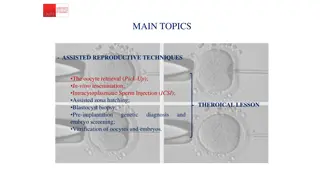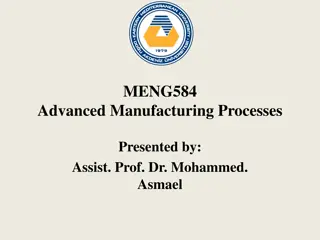Guidelines for Assisted Vaginal Birth Delivery
Assisted vaginal birth using forceps or vacuum extractor is recommended in cases of suspected fetal compromise or maternal exhaustion. Indications include lack of progress during labor, maternal medical conditions, or combined factors. Full abdominal and vaginal examinations are necessary before preparation and ensuring the mother's consent and cooperation. Adequate anesthesia, bladder emptying, and catheter removal are essential prior to the procedure.
Download Presentation

Please find below an Image/Link to download the presentation.
The content on the website is provided AS IS for your information and personal use only. It may not be sold, licensed, or shared on other websites without obtaining consent from the author. Download presentation by click this link. If you encounter any issues during the download, it is possible that the publisher has removed the file from their server.
E N D
Presentation Transcript
A S S I S S T A N T P R O F E S S O R D R . M A N A L M A D A N Y
REFERS TO A VAGINAL BIRTH WITH THE USE OF ANY TYPE OF FORCEPS OR VACUUM EXTRACTOR (VENTOUSE).
INDICATIONS FOR ASSISTED VAGINAL DELIVERY A-Fetal indications: Suspected fetal compromise (CTG pathological, abnormal pH or lactate on fetal blood sampling, thick meconium) B- Maternal indications: Nulliparous women lack of continuing progress for 3 hours (total of active and passive second stage of labour) with regional anesthesia or 2 hours without regional anesthesia. Multiparous women lack of continuing progress for 2 hours (total of active and passive second stage of labour) with regional anesthesia or 1 hour without regional anesthesia Maternal exhaustion/vomiting/distress Medical indications to avoid prolonged pushing or valsalva (e.g. cardiac disease, hypertensive crisis, cerebral vascular disease, particularly uncorrected cerebral vascular malformations, myasthenia gravis, spinal cord injury) C- Combined indications: Fetal and maternal indications for assisted vaginal delivery often coexist. The threshold to intervene may be lower where several factors coexist
-FULL ABDOMINAL AND VAGINAL EXAMINATION Head is 1/5 palpable per abdomen (in most cases 0/5 palpable) Head is 1/5 palpable per abdomen (in most cases 0/5 palpable) Cervix is fully dilated and the membranes ruptured Cervix is fully dilated and the membranes ruptured Station at level of Station at level of ischial ischial spines or below (0/+1/+2/+3) spines or below (0/+1/+2/+3) Exact position of the head has been determined so correct placement of the instrument can be Exact position of the head has been determined so correct placement of the instrument can be achieved achieved Caput and Caput and moulding moulding is no more than moderate is no more than moderate Pelvis is deemed adequate Pelvis is deemed adequate : :
B-PREPARATION OF MOTHER Clear explanation given and informed consent obtained Clear explanation given and informed consent obtained Trust has been established and woman offers full cooperation Trust has been established and woman offers full cooperation Appropriate anesthesia is in place; for mid Appropriate anesthesia is in place; for mid- -pelvic rotational delivery this will usually be a regional block; a delivery this will usually be a regional block; a pudendal the context of urgency; a the context of urgency; a perineal perineal block may be sufficient for low delivery delivery Maternal bladder has been emptied recently Maternal bladder has been emptied recently In In- -dwelling catheter has been removed or balloon deflated Aseptic technique dwelling catheter has been removed or balloon deflated Aseptic technique Operator has the knowledge, experience and skill necessary Operator has the knowledge, experience and skill necessary Adequate facilities are available (appropriate equipment, bed, lighting) and access to Adequate facilities are available (appropriate equipment, bed, lighting) and access to an operating theatre an operating theatre Back Back- -up plan in place in case of failure to deliver up plan in place in case of failure to deliver pelvic rotational pudendal block may be appropriate in block may be appropriate in block may be sufficient for low- -pelvic or outlet pelvic or outlet
C- PREPARATION OF STAFF For mid For mid- -pelvic deliveries, theatre staff should be available immediately to allow a pelvic deliveries, theatre staff should be available immediately to allow a caesarean section to be performed without delay (<30 minutes); senior caesarean section to be performed without delay (<30 minutes); senior obstetrician should be present if a junior obstetrician is conducting the delivery obstetrician should be present if a junior obstetrician is conducting the delivery Anticipation of complications that may arise (e.g. shoulder dystocia, Anticipation of complications that may arise (e.g. shoulder dystocia, perineal trauma, postpartum hemorrhage). trauma, postpartum hemorrhage). perineal Personnel present that are trained in neonatal resuscitation Personnel present that are trained in neonatal resuscitation
Instrument types Instrument types 1 1- -Ventouse/vacuum extractors Ventouse/vacuum extractors 2 2- - Forceps Forceps
THE VENTOUSE COMPARED TO FORCEPS IS SIGNIFICANTLY MORE LIKELY TO BE ASSOCIATED WITH: - -Failure to achieve a vaginal delivery. -Cephalohaematoma (sub-periosteal bleeding) -Retinal hemorrhage. -Maternal worries about the baby.
THE VENTOUSE COMPARED TO FORCEPS IS SIGNIFICANTLY LESS LIKELY TO BE ASSOCIATED WITH: - -Use of maternal regional/general anesthesia. -Significant maternal perineal and vaginal trauma. -Severe perineal pain at 24 hours. The ventouse compared to forceps is similar in terms of: -Delivery by caesarean section (where failed vacuum is completed by forceps). -Low 5 minute Apgar scores . Ventouse/vacuum extractors
TECHNIQUE The basic premise of such instruments is that a suction cup, of a silastic or rigid construction, is connected, via tubing, to a vacuum source. Soft cups are significantly more likely to fail to achieve vaginal delivery than rigid cups, however, they are associated with less scalp injury. There appears to be no difference in terms of maternal injury. The soft cups are appropriate for straightforward deliveries with an occipitoanterior position; metal cups appear to be more suitable for occipitoposterior , transverse and difficult occipitoanterior position deliveries ,where the infant is larger or there is a marked caput
The cup located at the vertex which, in an average term infant, is on the sagittal suture 3 cm anterior to the posterior fontanelle and thus 6 cm posterior to the anterior fontanelle. The center of the cup should be positioned directly over this, as failure to do so will lead to a progressive deflexion of the fetal head during traction, and an inability to deliver the baby. The operating vacuum pressure for nearly all ventouse is between 0.6 and 0.8 kg/cm2.to increase the suction to 0.2 kg/cm2 first and then to recheck that no maternal tissue is caught under the cup edge. When this is confirmed the suction can then be increased. Traction must occur in the plane of least resistance along the axis of the pelvis the traction plane The maximum time from application to delivery should ideally be less than 15 minutes. Rotation is achieved by the natural progression of the head through the pelvis.
CONTRAINDICATIONS: In gestations of less than 34 completed weeks because of the risk of cephalohaematoma and intracranial hemorrhage. Face or breech presentation. There is minimal risk of fetal hemorrhage if the vacuum extractor is employed following fetal blood sampling trials comparing deliveries performed with forceps or ventouse.
It is not acceptable to use a ventouse when: 1-The position of the fetal head is unknown. 2-There is a significant degree of caput that may either preclude correct placement of the cup or, more sinisterly, indicate a substantial degree of CPD. 3-The operator is inexperienced in the use of the instrument.
FORCEPS Technique All the usual prerequisites for safe delivery apply, but in addition it is essential that the operator checks the pair of forceps to ensure that a matching pair has been provided and that the blades lock with ease (both before and after application). The left blade is inserted before the right with the operator s hand protecting the vaginal wall from the blades. With proper placement of the forceps blades, they come to lie parallel to the axis of the fetal head and between the fetal head and the pelvic wall. The operator then articulates and locks the blades, checking their application before applying traction. . .
Traction should be applied intermittently coordinated with uterine contractions and maternal expulsive efforts. The axis of traction changes during the delivery and is guided along the J -shaped curve of the pelvis. As the head begins to crown, the blades are directed to the vertical and the head is delivered. The majority of forceps deliveries will be completed in no more than three pulls. Specific techniques are required for rotational forceps deliveries and only those who have been properly trained in their use should employ them. Rotation occurs between contractions and the descent phase is similar to non-rotational forceps
CLASSIFICATION OF FORCEPS DELIVERY ACCORDING TO STATION AND ROTATION Type of procedure criteria forceps used Type of procedure criteria forceps used A high forceps vertex not engaged A high forceps vertex not engaged kielland kielland (Not longer used) (Not longer used) B mid forceps head is engaged but station above +2 Simpson B mid forceps head is engaged but station above +2 Simpson C low forceps station is more than +2 but had C low forceps station is more than +2 but had Not yet reached the pelvic floor Not yet reached the pelvic floor D out let forceps station more than +2 Wrigley D out let forceps station more than +2 Wrigley Fetal head on the perineum Fetal head on the perineum Scalp is visible at the Scalp is visible at the introitus Rotation <45 degree Rotation <45 degree Sagittal suture is in direct AP diameter Sagittal suture is in direct AP diameter Or Or Rt,Lt Rt,Lt OA or OP position OA or OP position introitus
FAILURE TO COMPLETE DELIVERY VAGINALLY CAN OCCUR WHEN:- 1-The choice of instrument is wrong (e.g. a silastic cup ventouse for a rotational delivery). 2-When the application of the instrument is wrong (e.g. ventouse application over the anterior fontanelle). 3- When the position has been wrongly defined (most commonly OP OA errors), leading to inappropriately large diameters presenting to the pelvis. 4- The fetus is large or maternal effort is poor.
WHERE THE FIRST INSTRUMENT FAILS: - If the reason for failure was cup detachment of a vacuum and the fetal head is OA and on the perineum, a low-pelvic or lift out forceps to complete delivery is acceptable and likely to be less traumatic than a second stage caesarean section. -If the instrument failed because there was little or no descent with the first pull of a correctly applied instrument with traction in the correct axis of the pelvis, then delivery must be by caesarean section as the likely diagnosis is CPD.
-If the instrument failed because the position was incorrectly defined, then the next option will either be a rotational instrumental delivery or a caesarean section. -If there is any uncertainty, senior help should be sought immediately and a full re-evaluation should take place, ideally in an operating theatre. In many cases, delivery by caesarean section will be the safer option for the fetus.




